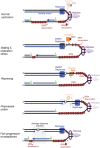Human PrimPol activity is enhanced by RPA
- PMID: 28396594
- PMCID: PMC5429719
- DOI: 10.1038/s41598-017-00958-3
Human PrimPol activity is enhanced by RPA
Abstract
Human PrimPol is a primase belonging to the AEP superfamily with the unique ability to synthesize DNA primers de novo, and a non-processive DNA polymerase able to bypass certain DNA lesions. PrimPol facilitates both mitochondrial and nuclear replication fork progression either acting as a conventional TLS polymerase, or repriming downstream of blocking lesions. In vivo assays have shown that PrimPol is rapidly recruited to sites of DNA damage by interaction with the human replication protein A (RPA). In agreement with previous findings, we show here that the higher affinity of RPA for ssDNA inhibits PrimPol activities in short ssDNA templates. In contrast, once the amount of ssDNA increases up to a length in which both proteins can simultaneously bind ssDNA, as expected during replicative stress conditions, PrimPol and RPA functionally interact, and their binding capacities are mutually enhanced. When using M13 ssDNA as template, RPA stimulated both the primase and polymerase activities of PrimPol, either alone or in synergy with Polε. These new findings supports the existence of a functional PrimPol/RPA association that allows repriming at the exposed ssDNA regions formed in the leading strand upon replicase stalling.
Conflict of interest statement
The authors declare that they have no competing interests.
Figures





Similar articles
-
[Point Mutations V546E and D547H of the RBM-B Motif Do Not Affect the Binding of PrimPol to RPA and DNA].Mol Biol (Mosk). 2024 Sep-Oct;58(5):840-848. Mol Biol (Mosk). 2024. PMID: 39970123 Russian.
-
Strand Displacement Activity of PrimPol.Int J Mol Sci. 2020 Nov 27;21(23):9027. doi: 10.3390/ijms21239027. Int J Mol Sci. 2020. PMID: 33261049 Free PMC article.
-
Human PrimPol is a highly error-prone polymerase regulated by single-stranded DNA binding proteins.Nucleic Acids Res. 2015 Jan;43(2):1056-68. doi: 10.1093/nar/gku1321. Epub 2014 Dec 29. Nucleic Acids Res. 2015. PMID: 25550423 Free PMC article.
-
Mechanism of DNA primer synthesis by human PrimPol.Enzymes. 2019;45:289-310. doi: 10.1016/bs.enz.2019.06.003. Epub 2019 Jul 13. Enzymes. 2019. PMID: 31627881 Review.
-
Mitochondrial DNA replication: a PrimPol perspective.Biochem Soc Trans. 2017 Apr 15;45(2):513-529. doi: 10.1042/BST20160162. Biochem Soc Trans. 2017. PMID: 28408491 Free PMC article. Review.
Cited by
-
Roles of OB-Fold Proteins in Replication Stress.Front Cell Dev Biol. 2020 Sep 11;8:574466. doi: 10.3389/fcell.2020.574466. eCollection 2020. Front Cell Dev Biol. 2020. PMID: 33043007 Free PMC article. Review.
-
Changes in the architecture and abundance of replication intermediates delineate the chronology of DNA damage tolerance pathways at UV-stalled replication forks in human cells.Nucleic Acids Res. 2022 Sep 23;50(17):9909-9929. doi: 10.1093/nar/gkac746. Nucleic Acids Res. 2022. PMID: 36107774 Free PMC article.
-
Telomeres and Cancer.Life (Basel). 2021 Dec 16;11(12):1405. doi: 10.3390/life11121405. Life (Basel). 2021. PMID: 34947936 Free PMC article. Review.
-
Polymerase iota (Pol ι) prevents PrimPol-mediated nascent DNA synthesis and chromosome instability.Sci Adv. 2023 Apr 14;9(15):eade7997. doi: 10.1126/sciadv.ade7997. Epub 2023 Apr 14. Sci Adv. 2023. PMID: 37058556 Free PMC article.
-
Replication protein A: a multifunctional protein with roles in DNA replication, repair and beyond.NAR Cancer. 2020 Sep 25;2(3):zcaa022. doi: 10.1093/narcan/zcaa022. eCollection 2020 Sep. NAR Cancer. 2020. PMID: 34316690 Free PMC article.
References
-
- Lipps, G. The replication protein of the Sulfolobus islandicus plasmid pRN1. Biochem Soc Trans32, 240–244, doi:10.1042/ (2004). - PubMed
Publication types
MeSH terms
Substances
LinkOut - more resources
Full Text Sources
Other Literature Sources
Molecular Biology Databases

